This article relies largely or entirely on a single source .(September 2018) |
The Dragon of Mordiford was said to reside just outside the Herefordshire village of Mordiford, at the confluence of the River Lugg and the River Wye.
This article relies largely or entirely on a single source .(September 2018) |
The Dragon of Mordiford was said to reside just outside the Herefordshire village of Mordiford, at the confluence of the River Lugg and the River Wye.
There are multiple accounts of the dragon that have it take different forms.
One version of the legend explains that the dragon – a wyvern in this account – was found by a little girl from Mordiford named Maud, who had desperately wanted a pet. While wandering the forest adjacent to her village one day, Maud had found a small bright creature with a snout and small, translucent wings prowling around a small group of flowers. Excited by the creature, the girl took it home to show to her parents. Immediately her mother and father realized it was a wyver and commanded Maud to take it back to where she had found it because it would cause trouble in the village. The indignant Maud pretended to obey but instead hid the infant dragon in a safe place in the forest. There she nurtured her "pet" with milk, playing with it and watching it try to fly. [1] The dragon grew vastly each month, eventually taking on an emerald hue and developing thick, powerful wings. [2]
In the legend, after reaching maturity, the dragon's hunger could not be satisfied with milk anymore—it now had an enormous hunger for meat. Soon, it began to plague the local farms, killing their livestock, especially cows and sheep, and farmers were intolerant. These men tried to stop the beast by extermination, but it soon feasted upon them, finding human flesh delicious. [2] Maud implored the beast during her visits afterward to stop its rampage. Still the beast, now fully mature, killed everything in its way except for Maud, its only friend. [2]
The townspeople in the tale grew exhausted of the constant attacks from the dragon and desperate, sought help from the noblemen of Mordiford. A man from the local Garstone family set out in full armour to end the beast's life forever, finding the beast nearly camouflaged into the forest's many plants. The dragon almost instantly released a blast of fire, Garstone barely deflecting it. He aimed a lance at the wyvern's throat, releasing it and fully penetrating through the dragon. Maud, insane with rage and grief, burst from the surrounding forest and came to mourn her past pet. [3]
In another account, the Mordiford Dragon was more serpentine and lived in Haugh Wood for some years. The poisonous creature terrorized the area to the point where it decreased the working population of the town. Eventually a local convict offered to kill the creature if he were given a pardon. The pardon was granted, and the convict acquired a bow, arrows, and a large cider barrel. He then went to the River Lugg where the serpent drank its water and concealed himself in the barrel. Once the dragon arrived at the river, the convict shot an arrow through a hole in the barrel, piercing the creature's heart. But as the dragon died, its poison flowed into the barrel, killing the convict as well. [4]

The story of the dragon remains part of Mordiford's culture: it is continually mentioned in modern records of the town. A portrait of the dragon – depicting it as a green wyvern – appeared on the wall of the main church of the village until the church was repaired and renovated in 1811. Supposedly it was removed because a rector considered it "heathenish." [2] [5] A reproduction of this painting of the dragon is displayed inside the church.[ citation needed ]
Some verses from 1670 refer to the dragon in the Mordiford church:
This is the true Effigy of that strange
Prodigious monster which our woods did range
In Eastwood it by Garston's hand was slaine,
A truth which old mythologists maintaine [5]
The name Garston corresponds to a local well-to-do family – one that the local parish records note that made charitable bequests to the local church in the 16th and 17th centuries. [5] Paul Newman speculates that the slayer's identity as a convict was added to the serpent version of the tale to make it into a "local villain-makes-good story." [6]
Supposedly, as late as 1875, a pair of old women could be seen killing newts from the River Lugg, believing that the animals were "the seed of the dragon" and that if they weren't ritually sacrificed, the dragon would reappear and wreak havoc once again. [5]
A local group has created the Mordiford Dragon Trail, which tells the story of the Maud and the Dragon with the help of statues on a 1.4 mile walk around the village. The Mordiford Dragon Trail opened in 2022 and begins on The Lower Green with an information board.[ citation needed ]

The European dragon is a legendary creature in folklore and mythology among the overlapping cultures of Europe.
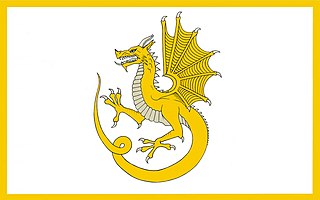
The wyvern is a type of mythical dragon with two legs, two wings, and often a pointed tail which is said to be a venomous stinger.

The River Wye is the fourth-longest river in the UK, stretching some 250 kilometres from its source on Plynlimon in mid Wales to the Severn estuary. For much of its length the river forms part of the border between England and Wales. The Wye Valley is designated an Area of Outstanding Natural Beauty. The Wye is important for nature conservation and recreation, but is affected by pollution.
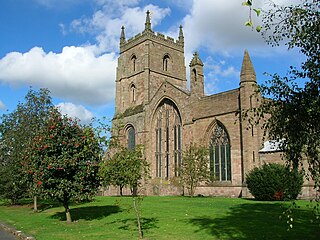
Leominster is a market town in Herefordshire, England; it is located at the confluence of the River Lugg and its tributary the River Kenwater. The town is 12 miles north of Hereford and 7 miles south of Ludlow in Shropshire. With a population of 11,700, Leominster is the largest of the five towns in the county; the others being Ross-on-Wye, Ledbury, Bromyard and Kington.

Hereford and Worcester was an English non-metropolitan county created on 1 April 1974 by the Local Government Act 1972 from the areas of the former administrative county of Herefordshire, most of Worcestershire and the county borough of Worcester. An aim of the Act was to increase efficiency of local government: the two counties are among England's smaller and less populous counties, particularly after the same Act transferred some of Worcestershire's most urbanised areas to the West Midlands.

Ross-on-Wye is a market town and civil parish in Herefordshire, England, near the border with Wales. It had a population estimated at 10,978 in 2021. It lies in south-east of the county, on the River Wye and on the northern edge of the Forest of Dean.
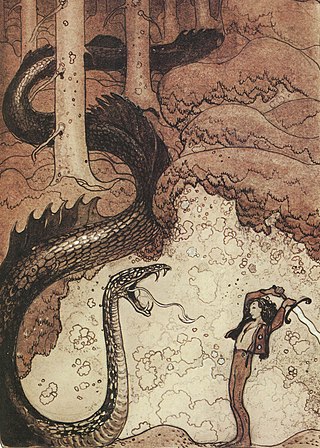
The lindworm, also spelled lindwyrm or lindwurm, is a mythical creature in Northern and Central European folklore that traditionally has the shape of a giant serpent monster living deep in the forest. It can be seen as a sort of dragon.

Herefordshire is a ceremonial county and unitary authority in the West Midlands of England. It is bordered by Shropshire to the north, Worcestershire to the east, Gloucestershire to the south-east, and the Welsh counties of Monmouthshire and Powys to the west. The city of Hereford is the largest settlement and the county town.

The River Lugg rises near Llangynllo in Radnorshire, Wales. It flows through the border town of Presteigne and then through Herefordshire, England, where it meets its main tributary, the River Arrow, to the south of Leominster. It flows into the River Wye downstream of Hereford at Mordiford, around 63 miles (101 km) from its source. Its name comes from a Welsh root, and means "bright stream".
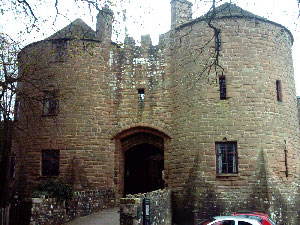
St Briavels, is a medium-sized village and civil parish in the Royal Forest of Dean in west Gloucestershire, England; close to the England-Wales border, and 5 miles (8 km) south of Coleford. It stands almost 800 feet (240 m) above sea level on the edge of a limestone plateau above the valley of the River Wye, above an ancient meander of the river. To the west, Cinder Hill drops off sharply into the valley. It is sheltered behind the crumbling walls of the 12th century St Briavels Castle.
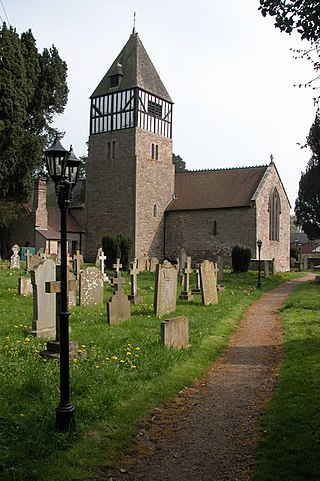
Hampton Bishop is a village and civil parish south-east of Hereford, in Herefordshire, England. The population of the civil parish at the 2011 Census was 505. The village itself is on a wedge between the River Wye and the River Lugg, not far from where the River Frome meets the Lugg.
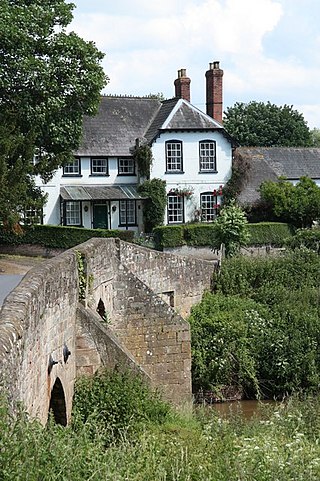
Mordiford is a village and civil parish in Herefordshire, England on the B4224 Hereford to Mitcheldean road 4 miles (6 km) east-southeast of the city of Hereford.
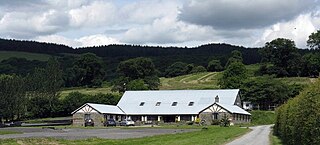
Kinsham is a civil parish which lies in the wooded hills of Herefordshire, England in the Marches near to the border with Wales, about 3 miles (5 km) east of the Welsh town of Presteigne. The parish has two small settlements, Upper Kinsham and Lower Kinsham, in the east overlooking the valley of the River Lugg, which marks the parish boundary.
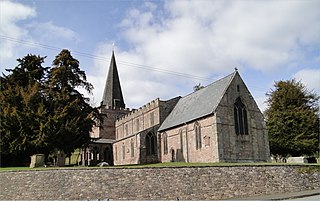
Dilwyn is a village in Herefordshire, England located about 18 km (11 mi) from the city of Hereford and 9 km (6 mi) from its nearest town, Leominster. It is situated on the northern edge of a broad valley that stretches from the River Wye through to Leominster. Running through the valley, south of the village, is the Stretford Brook whilst to the north are the rivers Arrow and Lugg.

Kinnersley is a village and civil parish in Herefordshire, England. The village is about 5 miles (8 km) east of the Wales-England border and 10 miles (16 km) north-west of Hereford.
Glasbury, also known as Glasbury-on-Wye, is a village and community in Powys, Wales. The village lies at an important crossing point on the River Wye, connecting the historic counties of Brecknockshire and Radnorshire, and is located just outside the Brecon Beacons National Park, north of the Black Mountains. The village is split between the communities of Glasbury and Gwernyfed. The nearest town is Hay-on-Wye, some 4 miles (6 km) to the north east. The nearest city is Hereford in England, some 25 miles (40 km) to the east. Glasbury is a popular location for river fishing, canoeing and kayaking. The population of Glasbury community in Radnorshire was 994, in 1841 it was 838.
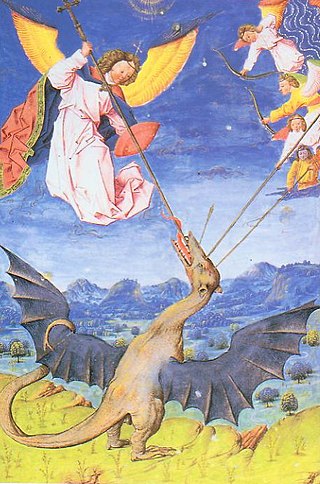
A guivre is a mythical creature similar to a dragon. In legend they were portrayed as serpentine creatures who possessed venomous breath and prowled the countryside of Medieval France. The words "guivre" and "givre" are spelling variations of the more common word "vouivre". Vouivre, in Franc-Comtois, is the equivalent of the old French word "guivre." All these forms are derived ultimately from Latin vīpera, as is English viper.
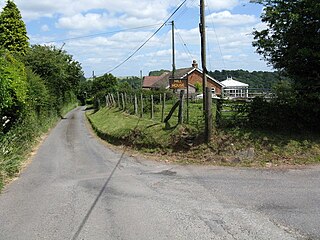
Newton is a linear settlement hamlet and civil parish in the county of Herefordshire, England, and is 10 miles (16 km) north from the city and county town of Hereford. The closest large town is the market town of Leominster, 3 miles (5 km) to the north. A Cadbury's confectionery factory is within the parish.

Kerne Bridge was built over the River Wye in the County of Herefordshire, England in 1825–28, on the site of an ancient ford crossing known as Flanesford. It is designated as a Scheduled Monument. Carrying the B4229 road, it connects the parishes of Walford on the river's left bank and Goodrich on the right. It is situated in the heart of the Wye Valley Area of Outstanding Natural Beauty and marks the northern end of the Upper Wye Gorge.

Sutton is a civil parish in Herefordshire, England, about 3 miles (5 km) north-east from the county town and city of Hereford. The major settlement is the village of Sutton St Nicholas which is conjoined with Sutton St Michael, formerly the village of a separate parish. The parish is sometimes referred to as Sutton St Nicholas. Within the parish is Sutton Walls, the supposed site of the palace of the kings of Mercia.